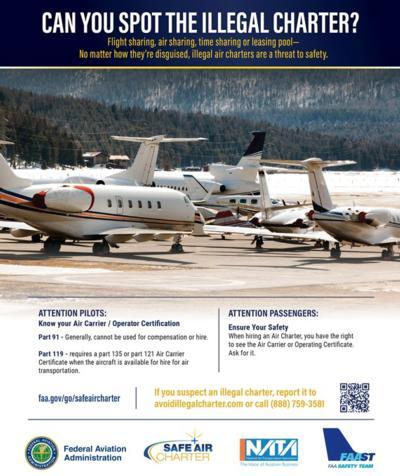Fri, Feb 04, 2022
Continuing Crackdown on Illegal Operations Puts Flight Sharing, Time Sharing, Leasing in Sights
In a follow on to a May 2020 informational pilot letter, amid a continuing operation to address unlawful and illegal air charter operations, the FAA has published its infographic for use at airports throughout the airport system.

The FAA reminds those who could be at risk of incorrectly applying expense sharing that guidance is available in Advisory Circular 61-142. The vintage bugbear of "holding out" has been brought back to life, newly invigorated by the societal shifts of ubiquitous smartphones. As automotive ridesharing platforms have transformed metropolitan transit systems, many operators and owners of light aircraft have looked on with jealousy at the ease of monetization and cost recoupment available to their terrestrial counterparts. A few attempts have been made to bring the same smartphone-level convenience to aviation, but difficulties in staying compliant have continued to make them untenable.
Alongside AC-61-142, the FAA takes note of AC 120-12A, which reminds pilots of the "common purpose test," i.e.,the rationale for a shared-cost ride must be something other than passenger carriage in order for a pilot using their private privileges in order to carry passengers. Carrying strangers for the sake of gaining time or to its own end, as many have found, is a good way to invoke the curiosity of a local inspector, made all the more probable with loose-lipped internet braggarts proud of their cool new travel arrangements. The admin reminds even professional pilots holding ATP or Commercial certificates that their induction into the paid-pilot club does not automatically anoint all their operations with regulatory compliance under the FARs. Reportedly, even well-experienced pilots often forget that while they themselves may be qualified in accordance with the applicable part 61 privileges and limitations, but the flight itself may be conducted under an operating rule as a part 91 or 135
flight.

Professional level pilots are also reminded by the FAA that they cannot hold out to the public unless they have been issued a part 119 certificate.
These issues are not new to the industry by any means, only re-energized. "Unauthorized 135 operations continue to be a problem nationwide, putting the flying public in danger, diluting safety in the national airspace system, and undercutting the business of legitimate operators," said the administration in its newsletter. The administration identifies two main pillars of misunderstanding remain "the misuse and/or misunderstanding of expense sharing between pilots and passengers, and the apparent lack of understanding of pilot privileges and limitations versus operating rules." The issue won’t disappear any time soon, but at the very least, those in the industry can remain wary of slip ups in their own operations.
More News
Also: Outlaw Prop 4 Mooney, Ready 4 Duty, Ukrainian F-16 Pilot Lost, Blue Origin Flt On his journey to become the first pilot to land solo on all seven continents, 19-year-old Etha>[...]
Also: DarkAero Update, Electric Aircraft Symposium, Updated Instructor Guide, OSH Homebuilts Celebrate The long-awaited Sonex High Wing prototype has flown... the Sonex gang tells >[...]
Discrete Code As used in the Air Traffic Control Radar Beacon System (ATCRBS), any one of the 4096 selectable Mode 3/A aircraft transponder codes except those ending in zero zero; >[...]
From 2023 (YouTube Edition): Deviation from the Historical Mean Racine, Wisconsin-based DeltaHawk is a privately-held manufacturer of reciprocating engines for aircraft and hybrid >[...]
Aero Linx: Formation and Safety Team (F.A.S.T.), USA The Formation and Safety Team (FAST) is a worldwide, educational organization dedicated to teaching safe formation flying in Wa>[...]
 Airborne 07.02.25: TikToker Arrested, Vietnam A/L Ground Hit, ATC Modernization
Airborne 07.02.25: TikToker Arrested, Vietnam A/L Ground Hit, ATC Modernization Airborne Affordable Flyers 07.03.25: Sonex HW, BlackShape Gabriel, PRA Fly-In 25
Airborne Affordable Flyers 07.03.25: Sonex HW, BlackShape Gabriel, PRA Fly-In 25 ANN's Daily Aero-Term (07.07.25): Discrete Code
ANN's Daily Aero-Term (07.07.25): Discrete Code Classic Aero-TV: DeltaHawk Aero Engine Defies Convention
Classic Aero-TV: DeltaHawk Aero Engine Defies Convention ANN's Daily Aero-Linx (07.07.25)
ANN's Daily Aero-Linx (07.07.25)




